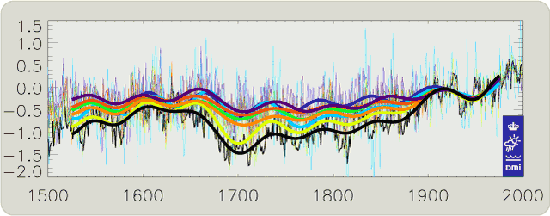"Hockey stick curve does not," says klimaforsker Bo Christiansen from Denmark's Climate Center and add. "That does not mean that we cancel the anthropogenic greenhouse effect, but the foundation has become more nuanced."
It caused great sensation, as Michael Mann and several others in 1998 published a curve of temperature evolution over the last 600 years in the northern hemisphere. The curve shows a steady, almost constant temperature of the first five centuries, interrupted by a sharp increase after 1900. It can be interpreted as if the natural variations are small compared to the anthropogenic warming. There followed a heated debate both inside and outside professional circles - a debate that will run yet.
Researchers at DMI now shows that the mathematical methods that are used for climate reconstruction, has serious limitations.

"Popular, one could say that the flat piece of hockey stick is too flat. The earlier reconstructions underestimate the potency of the natural climate variability," says Bo Christiansen and add. "In addition, this method a large element of chance."
Proxy Data
"Mann-curve is not directly based on measurements of temperature. We have only from about the mid-1800s," has klimaforsker and co in the new survey Torben Schmith on a previous occasion explained. "It restores instead - using a statistical method - temperatures from so-called 'proxy' climate indicators, such as the thickness of growth rings in trees, corals, ice cores and historical records," he explained.
The statistical methods used by the Danish researchers have looked closely at. By rewind the climate models that are normally used to predict future climate, back, they tested seven different reconstructive methods and exhibits all seven of the same weaknesses. "We are therefore faced a fundamental problem that limits the value of reconstruction studies," says Bo Christiansen.
"Climate models are so good that they are well suited to testing the previous methods to reconstruct climate. A climate model shows us a world that resembles reality with the same types of spatial and temporal variations. The advantage of the climate model is that we know its climate variability, not only the last 100 years but further back in time.
DMI-researchers' results have just been published in the Journal of Climate.
Original Danish website:
http://www.dmi.dk/dmi/klimaets_hockeystav_er_braekket
[See also this 2008 compilation of refutations of Mann's revived Hockey Stick at IceCap.US: target="_blank">Mann De-Bunking]



Looking at the original, I noticed that the translation in some places could be improved to make it easier to read and understand.
Just below where the subheading says Proxy data, the translation is closer to:
"The Mann-curve is not directly based on measurements of temperature. We have only measurements of temperature from about the mid-1800s," has climate researcher and co-author in the new survey, Torben Schmith, on a previous occasion explained. "Mann restores instead - using a statistical method - temperatures from so-called 'proxy' climate indicators, such as the thickness of growth rings in trees, corals, ice cores and historical records," he explained.
It is the statistical methods employed by Mann that the Danish researchers have looked closely at.